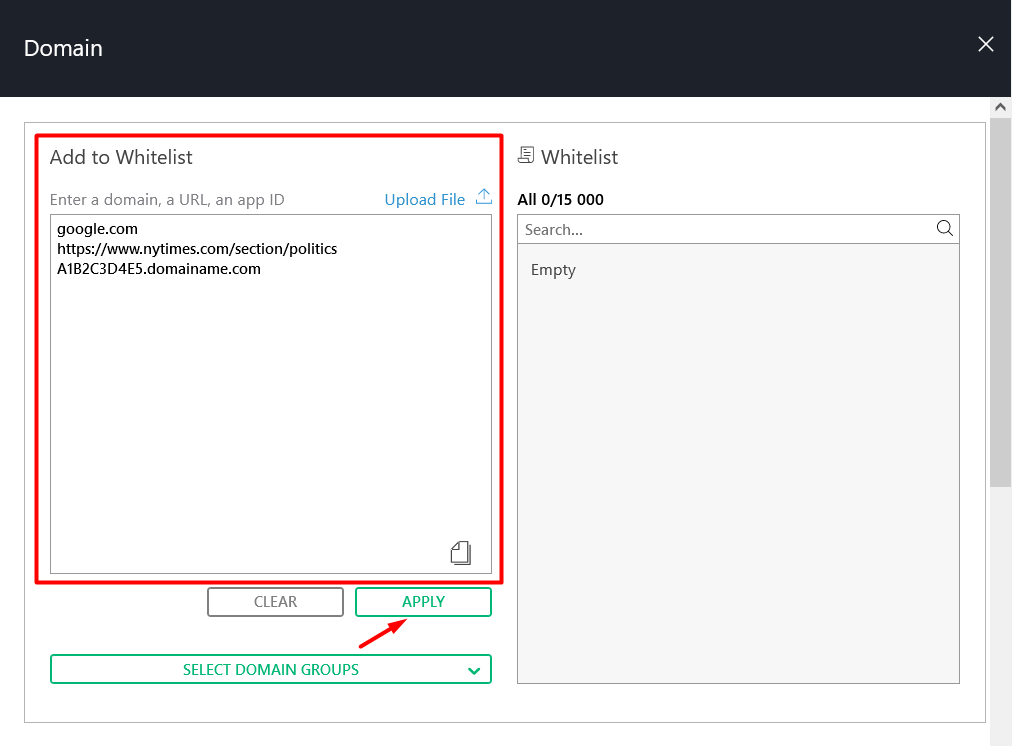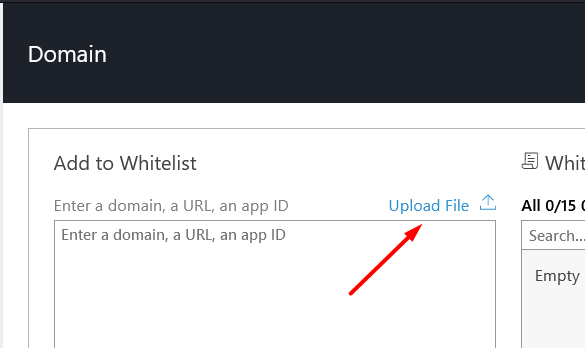Domain and URL targeting allows targeting ads to particular sites, domains, and mobile apps. The targeting runs two ways: whitelist and blacklist. You can also collect domains into groups and use them for targeting.
Whitelist and Blacklist
The whitelist consists of domains, sites, and App IDs where ads have to show.
Enter domains, URLs, and App IDs, which you want to include in targeting, in the Add to Whitelist block, and press Apply.

You will see the values you added in a Whitelist block on the right.
You can also upload a file with a list of domains, URLs, and App IDs. Press Upload File.
A list can contain up to 15,000 values. It means that a file you upload should contain no more than 15,000 values. All values must be in the first column. Also, the file should be .xls shouldn’t contain empty lines or more than one sheet.

If you often target ads to the same domains, try domain groups.
To add a domain group to a whitelist:
- Press Select Domain Groups.
- Choose groups you want to add.
- Press Apply.
You can add a domain group on a Domain Groups blade or a current targeting blade.
You create a blacklist the same way you do a whitelist.
Creating Domain Groups
To create a domain group in domain and URL targeting:
- Press Create Domain Group.
- Enter Name on the next blade.
- Enter domains or upload a file. The file shouldn’t contain empty lines and more than one sheet.
Maximum number of values is 15,000. - Press Apply.
- Press Save.
After that, you can see the group in a Select Domain Groups dropdown list as well as in Presets — Domain Groups.
Additional Settings
You can target ads to top-level domains. A top-level domain (TLD) is a part of the domain name right from the dot (com, net, org, etc.).
You have two setting options: Include and Exclude.
Include works as a whitelist, Exclude as a blacklist. It means if you want to target ads to particular TLDs:
- Enter a domain.
- Select Include.
- Press Add.
Repeat the steps to add more TLDs.
Select Exclude on step 2 to exclude a TLD from targeting. You can add no more than five TLDs on the whole.
URL Rules
Unlike domain targeting, URL rules allow to target ads by parts of URL—and it’s not necessarily a domain. These rules run by six principles:
- Contains: Yes — targets URLs that contain a part you entered;
- Contains: No — targets URLs that don’t contain a part you entered;
- Equal: Yes — targets a URL that is equal to the one you entered;
- Equal: No — targets any URL except the one you entered;
- Expression: Yes — targets URLs that correspond to a set regular expression;
- Expression: No — targets URLs that don’t correspond to a set regular expression.
To add a rule:
- Enter a part of the URL you need.
- Select one of the principles above.
- Press Add URL Rule.
You will see the rule in the interface. You can add up to 100 URL rules. They all work by two principles—AND and OR. The AND principle means that URL rules run at the same time. When you choose the OR principle, only one of the rules runs for one web page.
Example 1. AND principle.
You add a rule URL1 with Contains: Yes principle and a rule URL2 with Contains: Yes principle, and choose the AND principle. It means that an ad will show on a page whose link contains URL1 and URL2.
Example 2. OR principle.
You add a rule URL1 with Contains: Yes principle and a rule URL2 with Contains: Yes principle, and choose the OR principle. It means that an ad will show on a page whose link contains either URL1 or URL2.
